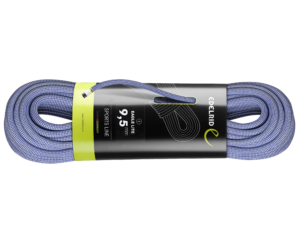Do you want to know what is the best rock climbing rope? Unless you’re Alex Honnold and prefer living life on the edge, rock climbing necessitates the use of a rope. And I’m not referring to the big hardware store rope you dragged out of your garage—any old rope will do.
Climbing ropes are intended to keep you safe in a variety of scenarios and settings. It is important to know the best rock climbing rope, their different types, lengths, and treatments, and which ropes work best for which climbing styles. Choose wisely the best rock climbing pant having these qualities.
The Climbing Ropes of Today
In the 1960s, Edelrid created the first modern climbing rope, the kernmantle,or “core jacket.” The contemporary climbing rope has two layers: an inner core and an outer sheath. The inner core is a dense, twisted network of nylon strands that provides dynamic stretch while catching a fall. The sheath is constructed of woven nylon strands, which protect the inner core.

Static vs. Dynamic
Climbing ropes, as opposed to static ropes, which do not stretch, extend to aid in absorbing the shock of a falling climber. Climbers use dynamic ropes for top-roping and leading. Static ropes are used for saving people, going into caves, and carrying loads. Now that you know you’ll need a dynamic rope, are you ready to go shopping?
Not quite. There are numerous sorts, lengths, styles, treatments, and color choices to pick from in the dynamic rope family. Let’s begin by analyzing the three varieties of dynamic ropes: single, double, and twin.
Varieties Of Climbing Rope

Individual Ropes
A single rope is the simplest technical system. Single ropes can withstand many falls on their own. Because the climber and belayer are only managing one rope at a time, the system is straightforward. This system’s flaws include a lack of redundancy and rappelling restrictions on multi-pitch climbs.

Half-Rope
The half-rope system involves the use of two ropes that are rated to withstand a single fall but not several falls. The leader connects to both ropes and alternates clipping strands into sections of protection to create redundancy. This can reduce rope drag on roving routes, making them excellent for traverses. The half-rope system necessitates advanced rope management abilities. One of the benefits is that you can stop paths from getting lost and rappel a whole rope length.

Twin Rope
Twin ropes are a two-rope system that functions as a single rope when used together. That is, the leader attaches both ropes to all components of protection.
The ropes are not rated to bear large falls separately, but when used together, they provide the same protection as a single rope. The fact that they are lightweight and that you can rappel the whole length of the rope are two of their best features. On the other hand, with a twin rope system, you need more rope management skills and expertise than with a single rope system.
Diameter Of Climbing Rope
Smaller-diameter ropes are lighter, but they don’t last as long. On the other hand, thicker ropes are heavier, but they last longer than their smaller counterparts. Consider the various diameters available from climbing rope manufacturers.
- The thickest single ropes offered are 9.8–10.2 mm. It is ideal to use them for climbing in a gym, climbing with aids, top-roping, and climbing in regions with abrasive rock like granite.
- 9.5-9.8 mm: This is an excellent range for an all-purpose single rope. They’re lightweight, sturdy, and easy to use for traditional or sport climbing.
- 9.4mm: Single ropes with a diameter of 9.4 millimeters or less are the best option for lengthy, alpine climbs, and multi-pitch when weight is an issue. They are not made to last as long as ropes that are thicker and can’t take as many falls.
- The diameter of most half ropes is between 8 and 9 millimeters, whereas the diameter of most twin ropes is between 7 and 8 millimeters.
Length Of Climbing Rope
Dynamic climbing ropes typically range from 30 to 80 meters in length. Nowadays, a 60-meter rope is a norm, but climbers are setting up routes with anchors that require a 70-meter rope to lower back to the ground.
Check with your local crag and the locations where you will most likely be climbing before obtaining a rope. Guidebooks are also useful for this, as they outline route heights and rappel distances. Owning both a 60 m and a 70 m rope has clear advantages for climbers who travel across the world.
Treatments For Climbing Ropes
Climbing rope manufacturers claim that damp climbing ropes lose up to thirty percent of their dynamic strength. When temperatures fall below freezing, a damp rope might freeze, becoming rigid and unwieldy. A wet rope is also much heavier to carry than a dry rope, which might be inconvenient on an adventure.
Unless you only climb rocks in a gym, rock climbing is an outdoor sport that requires you to deal with rain and snow. Modern rope manufacturers handle this issue by covering rope fibers with a water-repellent coating during the manufacturing process. This is known as “dry treatment,” and it has more advantages than just keeping your rope dry.
Dry treatment can reduce friction both on the outside and inside of the rope. This reduces drag, makes the rope easier to handle, and makes it last longer.
A Climber Viewing A Multi-Pitch Climbing Route
Dry treatments are given different names by different brands, but they all essentially mean the same thing. When shopping, pay attention to detail. Sometimes only the core or sheath is dry-treated. The best moisture protection will come from a dry treatment that incorporates both the core and the sheath.
Colors And Markings On Climbing Ropes
This is when many people consider the “fun” part of rope purchasing to begin. You should have a good idea of the type, length, and diameter of the climbing rope you want by now. Perhaps you have a favorite brand in mind, but within each style, there is a range of colors to pick from—some solid, some bi-pattern. While no hue is superior to another, there is one factor to consider: middle marks.
Marks In The Middle
The ability to identify the middle of your climbing rope is critical, and the easier the identification, the easier the rope management. It’s important to know where the middle of your rope is so that you can quickly thread it for a rappel and figure out if you have a sufficient rope to safely drop a climber back down to the ground.
Traditionally, this is done on solid ropes with a lengthy black color. What’s the issue with this? On dirty or dark-colored ropes, it can quickly wear off and become difficult to notice.
In response to this issue, several businesses have begun to use brighter colors. However, if you buy a solid-colored rope with lengthy smearing for a center mark, it will become difficult to see at some point. You may make the center mark more visible with some do-it-yourself adjustments.
Bi-Color And Bi-Pattern Ropes
Some ropes are made of two different colors or patterns that appear to meet in the middle. The contrast makes identifying the middle mark simple. Bi-pattern ropes are more expensive because they need more time and resources to create.
Coiled Climbing Rope On A Wooden Floor
- Positive? Your middle initial will never disappear. Also, the bi-pattern ropes look awesome.
- Negative? If you need to repair or cut one end of your rope, resulting in it being shorter than the other, the intersection of the bi-pattern will no longer represent the middle of the rope.
A Rating Overview
The Union Internationale des Associations d’Alpinisme (UIAA) sets climbing rope safety standards. The results of dynamic climbing ropes’ UIAA safety tests, like their fall rating, dynamic elongation, and static elongation, as well as their impact force, must be printed on the product packaging. While it is not necessary to grasp every variable of these terms, we will provide a basic explanation.
Best Rope For Rope Climbing
Single ropes with a diameter of 10 mm or more are best for climbing in climbing gyms, on big walls, when top-roping often, and learning how to climb on big walls and sports routes. When climbing using these techniques, you should use a rope that is thicker and more durable to prevent it from wearing out too quickly.
Summary
When roped rock climbing, NEVER use a static rope. Single rope systems are popular for trad, sport, and top-roping climbing. On multi-pitch wandering routes, as well as in ice climbing and mountaineering, half-rope systems are used. This type of climbing is sometimes called “trad climbing.”
In non-wandering multi-pitch rock climbing, ice climbing, and mountaineering, twin rope systems are among the most common types of ropes used. A single rope with a length of sixty meters is considered standard and will enable you to complete the vast majority of climbs across the world. However, you should first choose where you plan to climb before making the purchase.
Any type of climbing that takes place outside necessitates the use of ropes that have been dry-treated. This includes multi-pitch climbing, mountaineering, and ice climbing. Under NO circumstances should you use a sharpie to darken the center mark on your rope!
Only a marking pen designed specifically for use on ropes, such as Beal’s rope marker, should be utilized. Markers like Sharpies and other commercial pens and markers have chemicals in them that could make your rope weaker. It’s not worth your life to risk it. Purchase only a UIAA-certified rope.






